Traditional Welsh Christmas Recipes
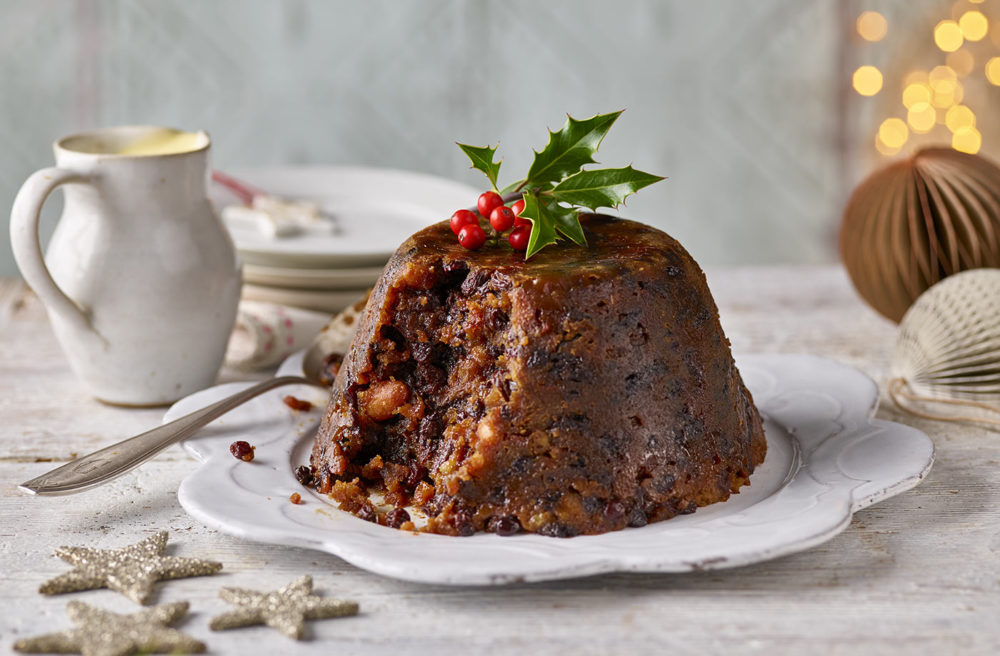
Wales has many centuries of Christmas history woven into its cuisine – with our own white sauce, goose blood tart and unique pudding – as well as the traditional drink of mead – and all can be easily made at home.
Various Welsh Christmas recipes have been handed down down through the centuries, and they are testaments to the region’s agricultural history and culinary creativity.
Here are a few classic Welsh Christmas recipes, from hearty puddings to sugary goodies.
Cacen Waed Gwyddau (Goose Blood Tart)
A deeply rooted Christmas tradition, Cacen Waed Gwyddau or goose blood tart, is an old Welsh dish that dates back to the 18th century.
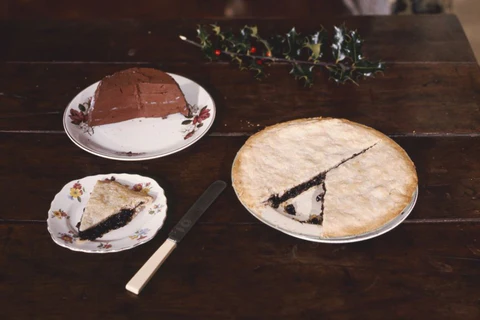
This cake was traditionally made using the blood from a goose.
From oral testimony, we know that this cake was an integral part of Christmas meals in the Trefeglwys area, as well as in the districts of Staylittle, Llanbryn Mair and Llangurig in Montgomeryshire.
Until today, however, there is no evidence that it was produced in any other county in Wales. The recipe below is based on the one shared by Amgueddfa Cymru, preserving its historic essence.
Ingredients:
1 lb goose blood (or substitute with pork blood if goose is unavailable)
2 lb plain flour
1/2 lb butter
1/2 lb sugar
3 eggs
1 tsp cinnamon
1 tsp nutmeg
A pinch of salt
Method:
1. Preheat the oven to 350°F (175°C) and grease a baking tin.
2. In a bowl, beat the eggs and sugar together until creamy.
3. Melt the butter and add to the egg mixture.
4. Mix in the flour, cinnamon, nutmeg, and salt.
5. Slowly add the goose blood and stir well to combine.
6. Pour the mixture into the prepared baking tin and bake for 1 hour or until the cake is firm.
7. Allow to cool before serving. It’s typically served with a cup of tea or warmed cider.
Tynnu Cyfaith (Toffee Making)
One of the sweetest traditions in Wales during Christmas is Tynnu Cyfaith, the practice of pulling toffee. This method involves cooking toffee to a hard stage, then pulling it until it’s glossy and light.
This treat is not only delicious but also provides a fun family activity during the festive season and some still keep the tradition alive today.
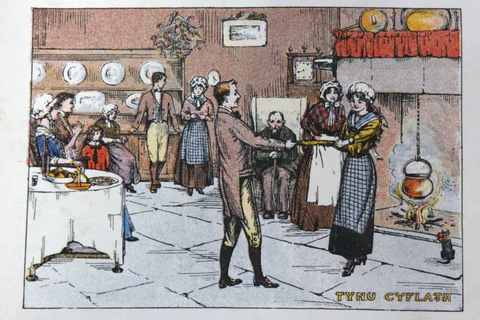
The ingredients (sugar, butter, and water) had to be boiled, and once ready, the mixture would be poured onto a greased slate or stone.
Then came the fun and challenge, as everyone greased their hands and tried to pull and twist the taffy until it was the right colour and shape. This was, of course, a matter of skill, and there was plenty of joking around as well.
Unsurprisingly, this tradition inspired poetry, as seen in a Christmas poem from the late Victorian era (1890) by Trebor Mai of the Conwy Valley, which reflects the spirit of the time:
Y Gwyliau sy’n dod a’i gelyn glas,
A’i gyflaith, a’i bwdin, a’i ŵyddau bras
Daw’r plant i enyn chwerthiniad iach
I’r aelwyd gynes yn Nghymru bach
– Trebor Mai, quoted from y Cymro, 18 September 1890
(Translation)
The holidays bring their bright foe,
With taffy, pudding, and fat geese in tow,
The children arrive with healthy cheer,
To the warm hearth in little Wales here.
Ingredients:
2 cups brown sugar
1 cup unsalted butter
1/2 cup heavy cream
1 tsp vanilla extract
Method:
1. In a large saucepan, combine the sugar, butter, and cream. Heat gently over low heat, stirring until the butter has melted.
2. Increase the heat and let the mixture boil for 10 minutes, stirring constantly to avoid burning.
3. Remove from heat and add the vanilla extract.
4. Allow the toffee to cool slightly before pulling it by hand until it turns pale and glossy.
5. Cut into pieces and allow to harden completely before serving.
Welsh Christmas Pudding
No Welsh Christmas meal is complete without a mouth-watering Christmas pudding. This recipe, a combination of Welsh recipes, brings a twist to the classic British Christmas pudding.
Casgliad y Werin Cymru (People’s Collection Wales) have a series recipies that were shared following an appeal by St Fagans National History Museum to coincide with their 2015 Food Festival.
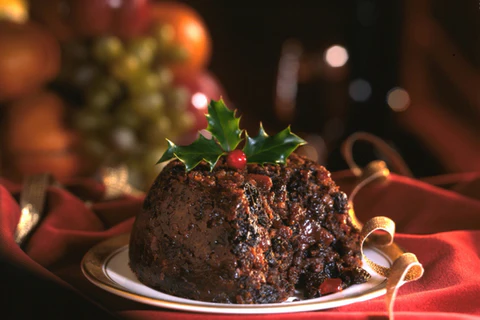
It was boiled as a single lump on a linen pudding cloth, giving it the names lump pudding, rag pudding or bag pudding. The mix was then clumped together and bound in a tight rope into a bag. The bag was then suspended from a stick above the cauldron or boiler and submerged in boiling water. A syrupy butter sauce was served with it.
Mixing Christmas pudding involved the whole family as every person in the family, from the youngest to the oldest, was to mix and make a secret wish. It was common practice as well, while making the pudding, to put some coins into the mix – those old silver threepenny or sixpenny pieces, which the recipients on Christmas Day considered to be good luck.
Ingerdients:
1/2 lb suet
1/2 lb mixed dried fruit
1/2 lb flour
1/2 tsp baking powder
1/4 tsp cinnamon
1/4 tsp nutmeg
1/2 cup dark brown sugar
2 eggs
1/2 cup dark beer or ale
Method:
1. In a large mixing bowl, sift the flour, baking powder, cinnamon, and nutmeg together.
2. Stir in the suet, dried fruit, and sugar.
3. Beat the eggs and add them to the mixture, followed by the beer.
4. Stir until all ingredients are combined and pour into a greased pudding basin.
5. Cover with greaseproof paper and steam for 6 hours, checking the water levels regularly.
6. Once cooked, serve with a rich brandy sauce or cream for a truly indulgent treat.
Mead (from the Gower Peninsula)
Mead (medd in welsh) is a medieval-derived drink and a festive Welsh beverage.
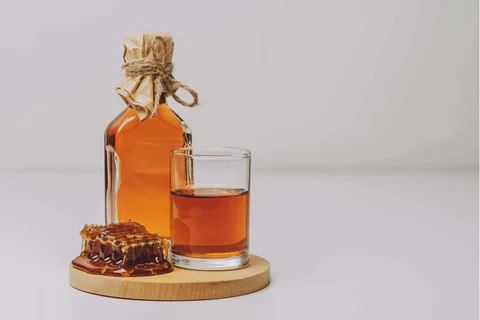
It’s made from fermented honey, water, and occasionally spices, and it is a popular part of festive celebrations.
Ingredients:
3 lb honey
1 gallon water
1/2 tsp yeast (for wine making)
A pinch of ginger and cinnamon (optional)
Method:
1. In a large pot, boil the water and dissolve the honey into it.
2. Remove from heat and allow the mixture to cool to room temperature.
3. Add the yeast and any optional spices (ginger, cinnamon) to the liquid.
4. Cover and leave to ferment for several weeks, stirring occasionally.
5. Strain the liquid and bottle the mead. Allow it to age for a few months before serving.
Welsh Loaf Cake
A delightfully rich cake, filled with sultanas and currants, the Welsh loaf cake is a festive favourite. This quick, yet delicious recipe is perfect for tea time or snacking.
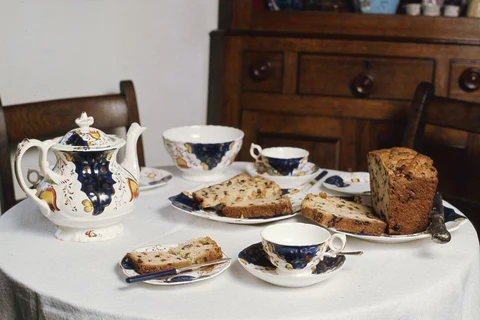
Is Welsh Loaf Cake the Same as Bara Brith?
Welsh loaf cake and bara brith are often thought to be the same, although there are a few important differences. Bara brith, or “speckled bread,” is a traditional Welsh tea loaf, traditionally made with dried fruit soaked in tea and perhaps sweetened with warming spices such as cinnamon. It’s usually eaten sliced and buttered, which makes it very comforting for the holidays.
A “Welsh loaf cake” in contrast may be defined as the same kind of baking without necessarily using the same classic technique or ingredients. Bara brith is traditional Welsh food, but a Welsh loaf cake might contain some innovative tweaks, such as other fruits or toppings.
Ingredients:
2 cups self-raising flour
1/2 cup butter
1/2 cup sugar
1/2 cup milk
1 tsp baking powder
1/2 cup sultanas
1/4 cup currants
1 egg
Method:
1. Preheat the oven to 350°F (175°C) and grease a loaf tin.
2. In a large bowl, cream together the butter and sugar until light and fluffy.
3. Beat in the egg and then stir in the flour, baking powder, milk, and dried fruits.
4. Pour the batter into the prepared tin and bake for 40-45 minutes, or until a skewer comes out clean.
5. Let the loaf cool before slicing and serving.
Currant Bread
Currant bread (Bara Cyrens) , sometimes enjoyed during Christmas, is a lightly sweet and soft bread made with a generous handful of currants, offering a simple yet delightful treat.
This currant bread was baked for special occasions only – to celebrate Christmas and the New Year and for Harvest Home Suppers.
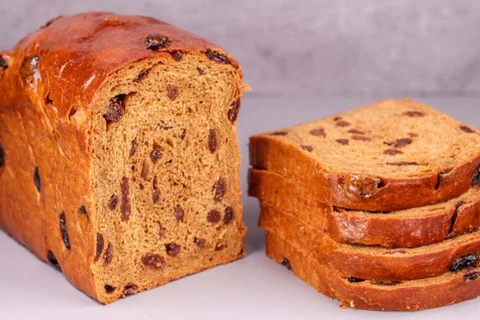
How does currant bread differ from loaf cake?
Currant bread comes in many forms, and recipes can vary widely. While simpler versions rely on currants for natural sweetness and have a lightly sweetened, bread-like texture, others incorporate richer ingredients like treacle, brown sugar, butter, and spices. These additions give the bread a sweeter, more indulgent flavor and a closer resemblance to loaf cake.
However, unlike loaf cakes, currant bread retains its traditional yeast-leavened base, which gives it a distinctively soft and chewy bread-like texture. It’s traditionally enjoyed plain or buttered with tea. Regardless of the variation, currant bread stands out for its focus on currants and remains a cherished treat with roots in traditional baking.
This particular recipe comes from Llanfachraeth, Anglesey. However, other variations can be found here.
Ingredients:
three pounds plain, white flour
two ounces dried yeast
fourteen ounces brown sugar
eight ounces lard
two ounces butter
one pound each of currants, sultanas and raisins
three ounces candied peel
one dessertspoonful black treacle
three teaspoonfuls salt
two eggs, well beaten
warm water
Method:
1. Mix the yeast and treacle in a little warm water and allow to ‘prove’ in a warm place.
2. Melt the lard and butter, and add the beaten eggs and sugar to them.
3. Put the flour, dried fruit and salt in a warm bowl, and add to the prepared liquid mixtures gradually, mixing all together thoroughly to make a soft dough.
4. Knead well, cover and allow to rise in a warm place for some three hours.
5. Then turn out on to a floured board, divide and shape into loaves according to the size of the tins.
6. Put the dough into warm and greased tins and allow to rise again in these tins until it becomes twice its original size.
7. Bake the loaves in a very hot oven (450°F) for the first hour, reduce heat to 400°F for the second hour and to 300°F for the third hour.
Welsh White Sauce
Welsh White Pudding Sauce, known in some regions as menyn melys (sweet butter), is a traditional accompaniment to desserts like Christmas pudding.
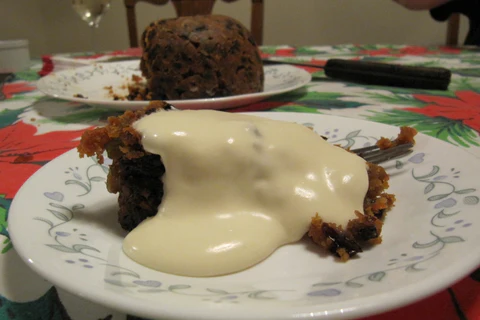
This sauce is cherished for its smooth texture and sweet, buttery flavour, enhancing the richness of festive treats.
Ingredients:
half a pint milk
approximately one cupful cold water
approximately two dessertspoonfuls plain flour (or cornflour)
a little sugar
a pinch of salt
a little rum (optional)
Method:
1. Blend the flour with a little of the milk.
2. Heat the water and the remainder of the milk in a saucepan and pour the flour mixture into it.
3. Add salt, sugar and rum to taste, and then bring to the boil, stirring continuously.
Serve hot, with Christmas pudding.
Community
Perhaps the most striking element of all these Welsh traditions from our perspective today is their communal nature.
Over the past few decades, we have come to think of the Christmas period primarily as a time for family, but traditionally it was a more social time.
Each of the customs mentioned above reflects this, with events where many would take part and an emphasis on creating together just as much as on eating and drinking together.
Read more interesting articles on all things Welsh at Welsh Words.
Support our Nation today
For the price of a cup of coffee a month you can help us create an independent, not-for-profit, national news service for the people of Wales, by the people of Wales.




